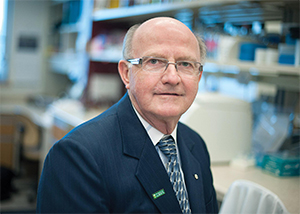Optimizing the value and efficacy of fundamental research in Canada
Author(s):
Lorne A. Babiuk

The launch of the Government of Canada’s Fundamental Science Review sends an important message to Albertans and Canadians: discovery-driven, fundamental science is an essential piece of the Canadian research landscape. In advancing this public discourse, the government is taking an important step toward strengthening a rich science culture where curiosity and discovery in all sectors of society is encouraged and fostered.
The timing of this review is critical. We are at a juncture where other nations are increasingly recognizing the central role that fundamental research conducted by universities plays in their ability to innovate. Canada’s higher education expenditure on R&D development (HERD) intensity ranking has fallen significantly from third in 2006 to seventh in 2014, as other nations outpace Canada in investments to their science and research foundations. 1
A solid fundamental research foundation is a requisite component of any thriving innovation ecosystem, but it has often taken a backseat to applied research, both in recognition and in funding. While both are indispensable and mutually reinforcing, curiosity-driven discovery research must be fostered if Canada is to be internationally recognized as a forward-thinking, world-class science leader that takes risks and pushes the boundaries of knowledge for the public good. Without discovery research there will be very little to commercialize in the future. Discovery research drives application.
Although there are a myriad of components necessary in a well-functioning research system, I would like to highlight four critical mechanisms to optimize the value and efficacy of fundamental research in Canada: fostering linkages with international colleagues; encouraging multi-disciplinarity and collaboration; implementing a big-picture perspective to encompass the full costs of research; and investing in the potential of early-career researchers.
Research is well-served when barriers between disciplines and lines of inquiry are reduced, allowing for the fruitful exchange of ideas and perspectives from individuals with a breadth of expertise. A diversity of people, ideas and resources inherent in inter-disciplinary projects is an indispensable component of dynamic research excellence, encouraging novel approaches to challenges that respond to the needs of a wide variety of Canadians. Although Canada’s research granting agencies have taken steps to cooperate across disciplines, more needs to be done to actively encourage multi-disciplinarity and make this a central priority for Canada’s science funding system so that it effectively addresses societal problems, many of which are not discipline specific.
As an example of the value of inter-disciplinary collaboration, the University of Alberta is creating the Future Energy Systems Research Institute (FESRI) through a $75 million CFREF grant. FESRI will integrate provincial, national and international teams in energy research, expanding inter-disciplinary collaborations in key areas—including engineering, sciences, social sciences, humanities, business and law—while addressing energy production as a system, rather than a series of discontinuous challenges. By working collaboratively across disciplines and institutions, Alberta’s post-secondary institutions are taking a system-wide approach to driving innovation to responsibly develop Canada’s natural resources and enable a smooth transition to a lower carbon energy economy.
To encourage the development of innovative and multi-disciplinary projects, Canada needs to adopt a fulsome approach to research funding. As it is impossible to predict when and where ground-breaking discoveries and disruptive innovations will occur, steps must be taken to ensure that the life-cycle of research projects is supported, including: foundational grants for basic research, initial infrastructure and equipment costs, ongoing operational and maintenance needs, administrative costs and personnel salaries, flexible funding for scaling-up of projects, costs associated with commercialization and even the final decommissioning of a project.
Providing a secure funding environment through supporting the full costs of research allows world-class researchers the flexibility and freedom to perform their best work, take bold risks and follow their research wherever it may take them, thereby increasing the chances of novel, innovative research outcomes to the direct benefit of society. This will pay further dividends for Canada with the outcome that the next generation of researchers and scientists will be trained to conduct research in a similarly bold, curiosity-driven manner. While it is important to support our highly-qualified researchers and faculty members at all stages of their careers, it is increasingly important to invest in our future innovators – the talented, energetic and ambitious cohort of early career researchers, including graduate students and postdoctoral fellows (postdocs) – at the beginning of their research and teaching careers.
The hiring of early career researchers in Canada has declined, replaced by an increasing over-reliance on sessional appointments. New tenure-track hires could be disadvantaged in a highly-competitive and uncertain environment, competing with more established researchers for limited grant funding. Canada cannot afford to lose its burgeoning talent; more can be done to foster a supportive environment for young researchers to thrive and reach the top of their respective fields.
As the national dialogue on the importance of discovery-driven, fundamental research progresses, it is my hope that a wide range of individuals will contribute to this review and together we can ensure Canada becomes more competitive. We look forward to the outcome of the Government of Canada’s Fundamental Science Review, and to the actions that are undertaken to enhance our country’s global competitiveness.
1 OECD, Main Science and Technology Indicators, p.63, 2016.

